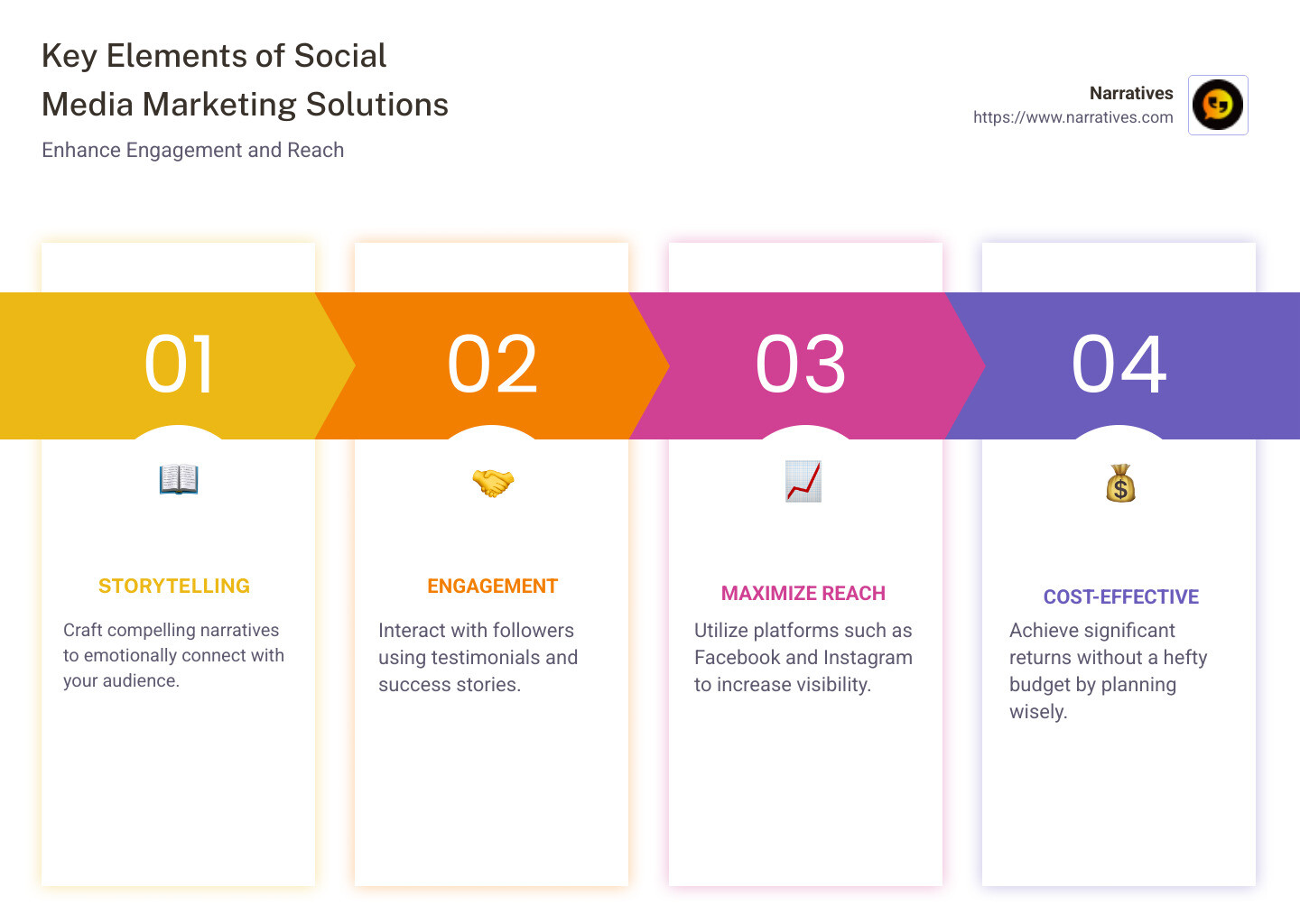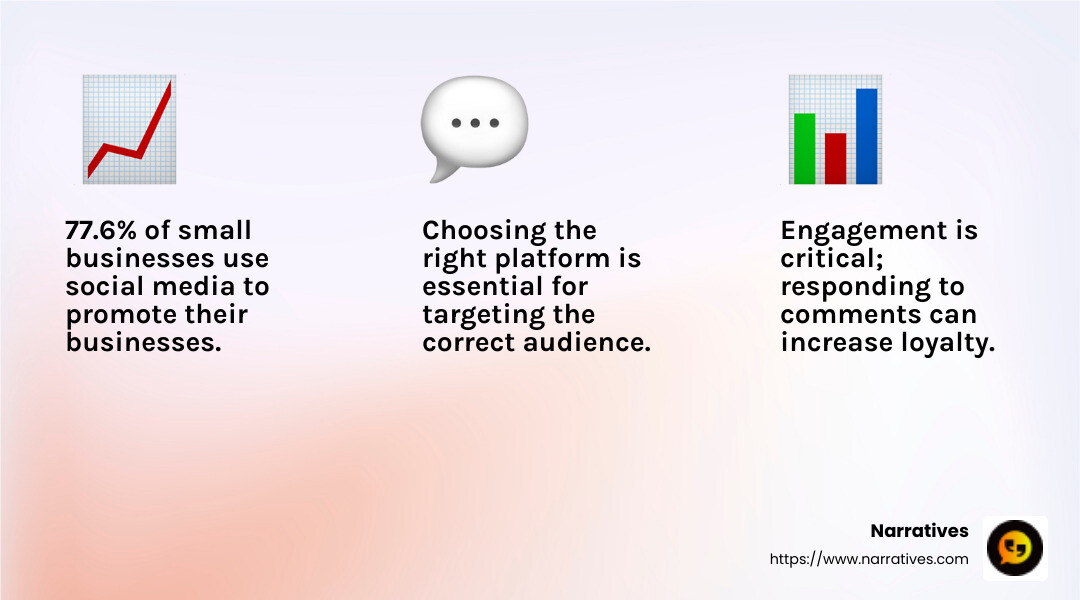Mastering the Art of Social Media Marketing Solutions

Social media marketing solutions have emerged as a powerful tool, changing how organizations reach and engage their audiences. This dynamic approach is essential for any mission-driven group looking to connect with their community on a deeper level. Here's a quick look at why social media marketing is important and how to leverage it:
- Lift Your Mission: Use storytelling and impactful content to highlight your cause and connect emotionally with your audience.
- Build Trust and Engagement: Engage followers by showcasing testimonials and success stories, strengthening community ties.
- Maximize Reach: Platforms like Facebook, Instagram, and LinkedIn offer custom strategies to boost visibility where your audience already engages.
- Cost-Effective Solutions: Achieve significant returns without hefty budgets by strategically planning your social media presence.
Social media marketing isn't just about posting updates; it's a strategic tool for building relationships and amplifying voices in a digital world.

Understanding Social Media Marketing Solutions
Social media marketing solutions are essential for reaching and engaging audiences in today's digital landscape. But what exactly are they?
Definition
At its core, social media marketing involves using platforms like Facebook, Instagram, and LinkedIn to promote a brand and connect with potential customers. It's more than just posting updates—it's about creating a dialogue and building a community around your cause or business.
Platforms
Choosing the right platform is crucial. Different platforms cater to different audiences and purposes:
- Facebook: Ideal for broad reach and community building. It's great for sharing stories and updates that resonate with a wide audience.
- Instagram: Perfect for visual storytelling. Use it to showcase your brand's personality through images and short videos.
- LinkedIn: Best for B2B interactions and professional networking. It's the go-to for sharing industry insights and connecting with other organizations.
Engagement
Engagement is the heart of social media marketing. It's not just about broadcasting messages but about interacting with your audience. Here’s how to foster engagement:
- Listen and Respond: Monitor comments and messages. Responding promptly can boost trust and loyalty.
- Encourage Participation: Use polls, questions, and interactive content to get your audience involved.
- Share Stories: People connect with stories. Share testimonials and user-generated content to build a sense of community.

By understanding and implementing these social media marketing solutions, organizations can effectively engage their audience and make a meaningful impact.
Key Components of Effective Social Media Marketing Solutions
Creating an effective social media marketing strategy involves several key components. Let's break down the essentials: content creation, audience targeting, and analytics.
Content Creation
Content is king in social media. It's what captures attention and keeps your audience engaged. To create compelling content:
Visual Appeal: Use eye-catching images and videos. Platforms like Instagram thrive on visual content, so make sure your visuals are high-quality and relevant.
Consistent Messaging: Your content should consistently reflect your brand's voice and values. This helps build trust and recognition.
Value-Driven Content: Share content that provides value to your audience. This can include tips, insights, or stories that resonate with them.
A great example of effective content creation comes from non-profits like Pars Equality Center, which uses storytelling to highlight their impact and engage their community.
Audience Targeting
Knowing your audience is crucial for any successful social media marketing strategy. Here's how to target effectively:
Identify Your Audience: Use data to understand who your audience is. Look at demographics, interests, and online behavior.
Platform Selection: Choose the platforms where your audience spends the most time. For instance, a B2B organization might focus more on LinkedIn, while a consumer brand could prioritize Instagram or Facebook.
Personalized Content: Tailor your content to meet the specific needs and interests of your audience. This increases engagement and conversion rates.
Analytics
Tracking and analyzing your social media performance is vital to understanding what's working and what needs improvement.
Engagement Metrics: Monitor likes, shares, comments, and other forms of engagement to gauge how well your content resonates with your audience.
Conversion Rates: Keep an eye on how many people are taking the desired action, whether it's signing up for a newsletter or making a purchase. Only about 22% of businesses are satisfied with their social media conversion rates, so there's often room for improvement.
Continuous Improvement: Use insights from analytics to refine your strategy. This might involve adjusting your content, changing your posting schedule, or exploring new platforms.
By focusing on these key components, organizations can craft effective social media marketing solutions that drive engagement and achieve their goals.
Next, we'll explore how non-profits can leverage these solutions to tell their stories and engage their communities.
Top Social Media Marketing Solutions for Non-Profits
Non-profits often have unique challenges when it comes to marketing. But with the right social media marketing solutions, they can amplify their message and drive real change. Let's explore some strategies that can make a big impact.
Storytelling
Storytelling is at the heart of every successful non-profit campaign. It's about connecting with people on an emotional level and showing the real-world impact of your work.
Highlight Real Stories: Share the journeys of those you've helped. For example, Pars Equality Center uses storytelling to showcase the lives of Persian-speaking immigrants and how their initiatives make a difference.
Visual Storytelling: Use images and videos to bring stories to life. A picture can speak a thousand words, and a video can tell an entire story.
Consistent Narrative: Keep your narrative consistent across all platforms. This helps build a strong and recognizable brand identity.
Community Engagement
Engaging with your community is crucial for building trust and fostering long-term relationships.
Interactive Content: Create polls, Q&A sessions, and live videos to engage your audience. This not only boosts engagement but also makes your community feel heard and valued.
Respond to Feedback: Actively respond to comments and messages. This shows that you care about your community's opinions and are willing to listen.
Collaborate with Influencers: Partner with influencers who align with your mission. They can help spread your message to a wider audience and lend credibility to your cause.
Impact Measurement
Finally, measuring your impact is essential to understanding the effectiveness of your campaigns and making informed decisions.
Track Key Metrics: Monitor metrics like engagement rates, follower growth, and website traffic. This data can provide insights into what's working and what needs improvement.
Use Analytics Tools: Leverage tools that offer in-depth analytics. These can help you understand your audience better and tailor your strategy accordingly.
Report and Reflect: Regularly report your findings to stakeholders and reflect on your successes and areas for improvement. This transparency builds trust and accountability.
By focusing on these elements, non-profits can harness the power of social media to tell compelling stories, engage their communities, and measure their impact effectively.
Next, we'll dive into how to implement these strategies effectively, starting with goal setting and platform selection.
How to Implement Social Media Marketing Solutions
Implementing effective social media marketing solutions involves a clear plan and thoughtful execution. Here’s how to do it right.
Goal Setting
Start with clear goals. What do you want to achieve with your social media efforts?
Be SMART: Your goals should be Specific, Measurable, Attainable, Relevant, and Timely. For instance, aim to increase web traffic by 25% in the next six months.
Align with Mission: Ensure your goals align with your organization's mission. This helps maintain focus and direction.
Prioritize: Decide what’s most important—whether it's building brand awareness, increasing engagement, or driving donations.
Platform Selection
Choosing the right platform is crucial. Not all platforms will suit your needs or audience.
Know Your Audience: Research where your audience spends their time. For example, non-profits might find Facebook and Instagram useful for B2C engagement, while LinkedIn is great for B2B connections.
Consider Content Type: Different platforms cater to different types of content. Instagram is ideal for visuals, while LinkedIn is better for professional content.
Limit Your Focus: Don’t spread yourself too thin. Focus on 2-3 platforms where you can engage effectively.
Content Strategy
A strong content strategy is key to engaging your audience and achieving your goals.
Create Valuable Content: Share content that resonates with your audience. This could be educational, entertaining, or inspiring.
Plan Ahead: Use a content calendar to plan posts in advance. This ensures consistency and helps manage time better.
Engage and Adapt: Listen to your audience. Engage with them by responding to comments and messages. Adapt your strategy based on feedback and analytics.
By setting clear goals, selecting the right platforms, and crafting a thoughtful content strategy, you can implement social media marketing solutions that drive meaningful results. Next, we'll address frequently asked questions to further clarify these strategies.
Frequently Asked Questions about Social Media Marketing Solutions
What are social media marketing solutions?
Social media marketing solutions are strategies and tools used to promote and grow your brand on social media platforms. They help businesses connect with their audience, increase brand visibility, and drive engagement. These solutions often include content creation, audience targeting, and analytics to measure success.
For example, a non-profit organization might use Facebook to share impactful stories about their work, Instagram to post engaging images and videos of their community efforts, and LinkedIn to connect with potential corporate partners.
How can social media marketing solutions benefit non-profits?
Social media marketing solutions offer several benefits to non-profits:
Visibility: Social media platforms provide non-profits with an opportunity to reach a wider audience. By sharing stories and updates, organizations can increase awareness of their mission and attract new supporters.
Engagement: Social media allows non-profits to interact directly with their audience. This engagement can build a community of loyal supporters who are more likely to donate, volunteer, or spread the word about the organization.
Cost-Effective: Compared to traditional marketing, social media is often more affordable, making it an attractive option for non-profits with limited budgets.
What are the best platforms for social media marketing?
Choosing the right platform is essential for effective social media marketing. Here are some of the best platforms:
Facebook: Ideal for reaching a broad audience, Facebook is great for sharing stories, events, and updates. Its robust advertising options also allow for targeted campaigns.
Instagram: Perfect for visual storytelling, Instagram is popular among younger audiences. Non-profits can use it to showcase their work through photos and videos, making it a powerful tool for engagement.
LinkedIn: Best suited for professional networking, LinkedIn helps non-profits connect with corporate partners, donors, and volunteers. It’s an excellent platform for sharing thought leadership content and building professional relationships.
By leveraging these platforms effectively, non-profits can improve their visibility and engagement, driving their mission forward.
Conclusion
As we wrap up our exploration of social media marketing solutions, it's clear that these tools are not just about increasing visibility or engagement. They are about crafting narratives that resonate deeply with your audience and inspire action. At Narratives, we understand the power of storytelling to amplify the voices of non-profits and purpose-driven organizations.
Storytelling is at the heart of what we do. It transforms facts and figures into compelling stories that capture the essence of your mission. Through high-quality, emotionally resonant multimedia content, we help you share your impact stories in ways that build trust and foster community.
The impact of effective social media marketing extends beyond traditional metrics. It's about creating a ripple effect that mobilizes support, drives change, and ultimately makes the world a better place. By leveraging platforms like Facebook, Instagram, and LinkedIn, non-profits can connect with diverse audiences, engage supporters, and cultivate lasting relationships.
At Narratives, we are committed to partnering with non-profits to lift their stories and maximize their impact. Our media network services are designed to support your journey in meaningful ways. Together, we can master the art of social media marketing solutions to create lasting change.


